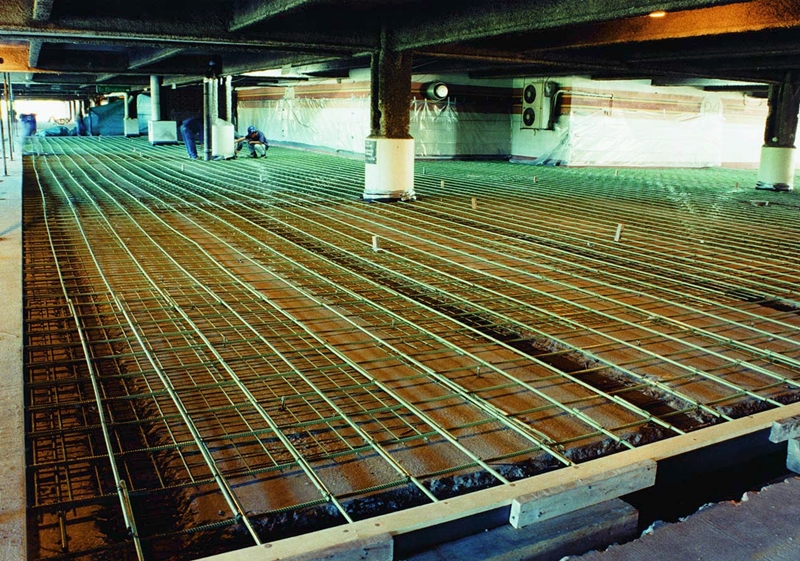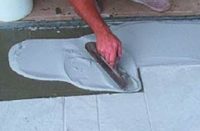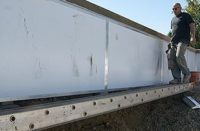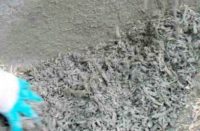 No matter what bonding agent is used, proper preparation of the substrate is essential for a successful, lasting bond.
No matter what bonding agent is used, proper preparation of the substrate is essential for a successful, lasting bond.
Bonding agents are a widely debated family of products. Some concrete contractors will tell you they have a favorite bonding agent, one that they use almost exclusively. Others say they evaluate every job and develop a unique solution, drawing from a wide range of products. And there are some contractors who swear by the oldest bonding agent of them all, simply using a mixture of portland cement and water. In fact, there are dozens of products and methods that may be used to create a bond between old concrete and new.
If there’s one thing that nearly all contractors agree on, it’s this: no matter what bonding agent is used, proper preparation of the substrate is essential for a successful, lasting bond. “Regardless of the manufacturer, polymer-modified toppings are only as good as the substrate on which they are installed,” says Scott Truax, president of the Concrete Division of Vail, Colo.-based Gallegos Corp.
Bonding agents fall into two basic categories, cement-based bonding agents (which include simple solutions like a slush coat or a scrub coat as well as a wide variety of latex-modified bonding agents), and epoxy bonding agents.
And new products are being introduced all the time. “New bonding agents today allow you to apply it and let it get to a hard state, where you can walk on it while it’s tacky,” says Bob Ware, owner of the Decorative Concrete Store in Cincinnati. This allows the contractor to do larger areas at a time, he says, saving time and costs on big jobs.
Other manufacturers are adding tint to bonding agents so contractors can ensure even and complete coverage. The bottom line: contractors have to find the methods that work for their unique jobs to ensure a complete, lasting bond.
The classics: cement-based bonding agents
Some contractors swear by the most traditional method of bonding new concrete overlays to old concrete surfaces, using the materials at hand. When applied correctly, this approach can prove adequate for many situations, and benefits include ease of application (no mixing of additional materials is required), speed, and low cost. The substrate should be prepared so that it is saturated surface dry (SSD).
One approach is to use a scrub coat, where the repair mortar or concrete overlay material is literally scrubbed into the prepared substrate. Experts caution against adding any water to the scrub coat material, because excess water will weaken the bond. To create the most effective bond, a scrub coat must contain enough fines and cement paste to penetrate the pores of the substrate.
Another method is to use a slush coat (or slurry coat), which is comprised of portland cement and water. The smooth, flowing material ensures penetration of pores in the substrate, creating a strong bond. In some cases, contractors incorporate sand into the mix. A drawback to the slush coat method is that the material dries very rapidly, so overlay material must be applied very quickly after application of the slush coat.
In the mix: latex-modified bonding agents
Latex-modified bonding agents come in a wide variety of formulations, and contractors should always follow the manufacturer’s instructions for the product they choose to use. This group of bonding agents can add significant strength to bonds between old and new concrete. In many cases latex-modified bonding agents are mixed with cement to create a slurry for application, but some contractors choose to apply the latex emulsions directly.
Acrylic resins
Acrylic resins are non-re-emulsifiable bonding agents that act like a glue. These agents can be applied with a broom, brush, spray, or roller, and the overlay is applied while the agent is still wet. “Typically in decorative concrete, they won’t be used as an additive,” says Bruce Kreielsheimer, director of operations for Flemington, N.J.-based manufacturer Anti-Hydro International Inc. Even so, these agents are compatible with cementitious materials. “If you add it, it will add a little shine to the surface — some want it, some don’t.” Acrylic resins generally are used for indoor or outdoor settings, but are not recommended for use in areas that will experience extreme chemical exposure.

The introduction of acrylic bonding agents brought increased flexibility to the concrete overlay market, says Ware. “Acrylic resins work as binding agents, and increase the strength of the overlay and the bondability of the old to the new,” he says. (Ware also runs RKC Increte, a decorative concrete installation company.) “We use it primarily for 1⁄4-inch overlays, and for self-leveling overlays and riser faces.” Because acrylic resins speed up the set time of concrete, Ware adds a retarding agent, enabling him to cover more area before the material sets.
Styrene butadiene (SBR) latex
Like acrylic resins, styrene butadiene (SBR) latex bonding agents are non-re-emulsifiable and are compatible with cementitious materials, and are sometimes used as an admixture when creating overlays. The materials are applied using a spray, brush, or roller. While they are used regularly for both indoor and outdoor applications, they are not recommended for areas that will receive significant water or chemical exposure.
Polyvinyl acetate (PVA)
Two kinds of polyvinyl acetate (PVA) bonding agents are used in decorative concrete applications: re-emulsifiable and non-re-emulsifiable.
Re-emulsifiable PVAs produce a film over the substrate that can be allowed to dry, which later becomes soft again with the application of the overlay material, offering the benefit of significant advance application time. But the material is not recommended for outdoor use, where humidity or rain can trigger premature re-emulsification. Application can be done with a spray, brush or roller.

Tim Blankenship, division manager of Atlanta-based Precision Concrete Construction, stays away from re-emulsifiable PVAs. “There is an opportunity to contaminate the agent if you let it set before you apply (the overlay),” Blankenship says, noting that the bond may be compromised as a result. Others see the agent’s ability to re-emulsify as a benefit. “Its advantage is, you can let it totally dry,” says Kreielsheimer. On big jobs, this can be a boon to contractors, who “don’t have to work a few feet ahead of themselves.”
Non-re-emulsifiable PVAs offer good water resistance and wear well. They are applied with a spray, brush, broom or roller, and may be used in a wider variety of applications both indoors and outdoors.
Lay it on: epoxy bonding agents
Epoxy bonding agents contain no cement, and generally are more expensive than cementitious bonding agents, but offer excellent bonding strengths. “Government agencies specify them constantly,” says Kreielsheimer. With their incredibly strong bonds, epoxies generally are recommended for jobs that require significant repair work.
Epoxies must be applied to a dry substrate. Overlays should be applied while the epoxy bonding agent is still wet. Bob Pirro, branch manager of Structural Preservation Systems Inc.’s Hawthorne, N.J. office, says a common mistake contractors make when using epoxy bonding agents is allowing them to cure too long: “Then it acts as a de-bonding agent,” he says. “It becomes like glass and the fresh concrete doesn’t bond.”
There are even products that combine the best of both worlds. Pirro says his company regularly uses an epoxy-modified cementitious bonding agent, which also provides an anti-corrosion coating, for doing spall repair and other types of concrete repair work. The product allows his crew to coat rebar and concrete substrate at the same time.

Needs analysis and preparation for success
Any discussion of bonding agents would be incomplete without addressing the importance of — and methods for — substrate preparation. According to Blankenship, the single biggest mistake a contractor can make is inadequate preparation: “There must be surface prep before the bonding agent. Not having it thoroughly cleaned, or if the preparation you do causes microfractures in the surface, can cause an overlayment to become delaminated.”
Surface preparation starts with cleaning the surface, clearing it of contaminants. A range of techniques is available for profiling the surface for bonding agent application, and Kreielsheimer says contractors should perform a needs analysis before making a decision on which material to use, asking questions like: “What is the substrate? What is the cementitious material you’re bonding to it? How much abuse will the finished surface receive?”
The surface can then be prepared using one of a variety of methods, including acid etching, sand blasting, shot blasting, scarifying, or bush hammering. In most cases, the rougher the prepared substrate, the better the bond. While contractors disagree on which method works best, all agree that preparation is critical to ensure adequate bond.













